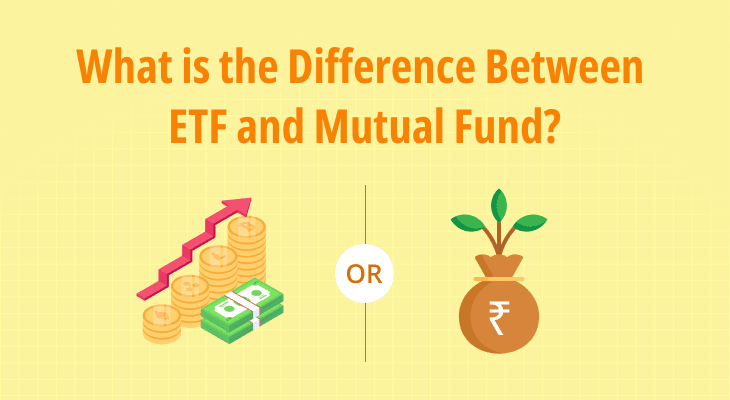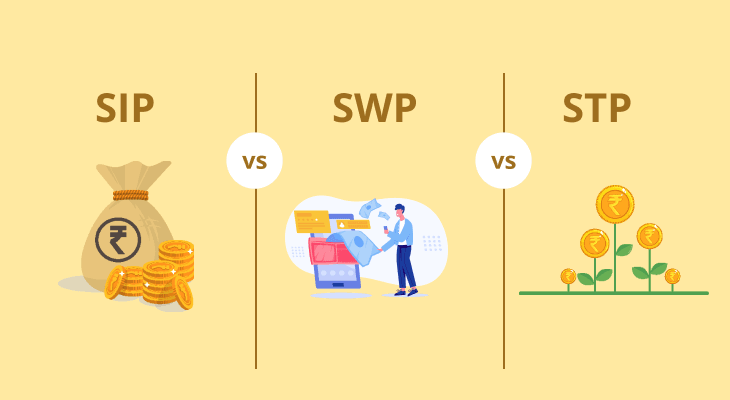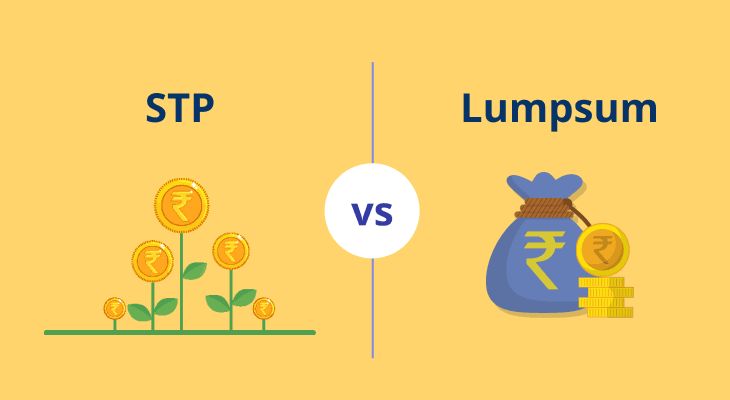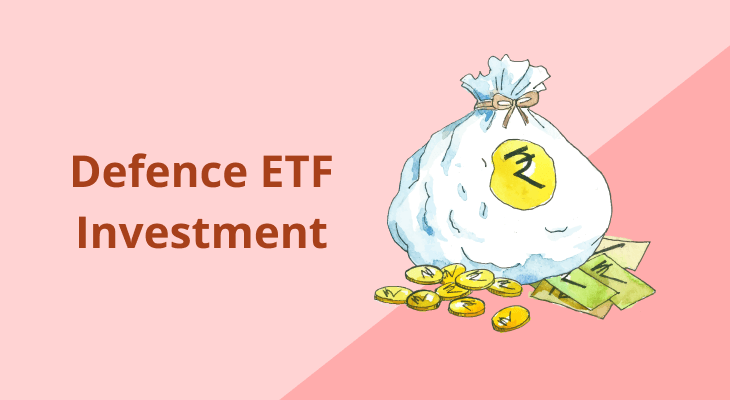
What is the Difference Between ETF and Mutual Fund?
Exchange-Traded Funds (ETFs) and mutual funds are two of the most popular investment tools in India. Both provide the possibility to diversify your portfolio and meet different financial goals in a convenient yet disciplined manner. Despite their obvious similarities, their operations, cost structures, and investment strategies differ considerably. Understanding what the differences between ETFs and mutual funds are can help you in making sound investment decisions. This article explores the key differences between ETFs and mutual funds, allowing you to evaluate which is most suited to your financial goals and risk tolerance.
What is an ETF?
An Exchange Traded Fund (ETF) is a type of investment fund that trades on stock markets, similar to individual stocks. ETFs are meant to mirror the performance of a certain index, sector, commodity, or asset. Here are some major features of ETFs.
- Passive Management: ETFs are usually passively managed. They seek to duplicate the performance of a certain index rather than outperform it.
- Liquidity: ETFs may be purchased and sold at market prices throughout the trading day, resulting in significant liquidity and flexibility.
- Lower Expense Ratios: Because of their passive management methodology, ETFs have lower expense ratios than mutual funds.
- Transparency: An ETF's holdings are often published on a daily basis, providing investors with transparency.
- Tax Efficiency: ETFs are considered to be tax efficient. They usually incur less capital gains taxes since they do not acquire and sell securities on a regular basis.
Types of ETFs
- Equity ETFs: Investment vehicles that seek to mirror the performance of a specific stock index.
- Bond ETFs: Focus on fixed-income instruments such as government and corporate bonds.
- Sector ETFs: These funds focus on particular industries, such as technology or healthcare.
- Commodity ETFs: Allows you to invest in physical goods such as gold and oil.
- International ETFs: Provide exposure to markets outside of the investor's home country.
What is a Mutual Fund?
Mutual funds are pooled investment vehicles managed by professional fund managers. It pools funds from various participants to invest in a diverse portfolio of stocks, bonds, and other securities. Mutual funds have the following key features:
- Active Management: Mutual funds are usually actively managed, with fund managers making decisions to outperform the market.
- Transaction Process: Mutual funds can only be purchased or sold at the close of the trading day at their Net Asset Value (NAV).
- Higher Fees: Mutual funds frequently charge higher management fees and expense ratios as a result of their active management.
- Diversification: Mutual funds provide extensive diversification across asset types.
- Tax Implications: Mutual funds can generate capital gains taxes when the fund manager decides to buy or sell securities.
Types of Mutual Funds
- Equity Funds: Invest largely in equities with the expectation of capital appreciation.
- Debt Funds: Invest in fixed-income instruments such as bonds with the goal of generating regular income.
- Hybrid Funds: Combine equity and debt assets to balance risk and return.
- Index Funds: Track a particular index and offer a low-cost investing choice.
- Tax-Saving Funds (ELSS): Provide tax benefits under Section 80C of the Income Tax Act, as well as possible capital appreciation.
How are ETFs and Mutual Funds Different ?
Feature | ETFs | Mutual Funds |
|---|---|---|
Management Style | Passively managed | Actively managed |
Trading and Liquidity | Traded on stock exchanges throughout the day | Bought and sold at the end of the day at NAV |
Cost Structure | Lower expense ratios | Higher management fees and expense ratios |
Minimum Investment | Typically allows smaller investment amounts | Often require a higher minimum investment |
Tax Efficiency | More tax-efficient | Less tax-efficient |
Transparency | Daily disclosure of holdings | Periodic disclosure of holdings |
Diversification | Targeted investments based on specific indices | Broad diversification across various asset classes |
ETF vs Mutual Fund
When choosing where to invest your money, it is important to comprehend the differences between Exchange-Traded Funds (ETFs) and mutual funds. Both ETFs and mutual funds are vehicles for diversifying your investments across a variety of assets, but they differ greatly in how they work and their benefits.
Structure and Trading Flexibility
ETFs and mutual funds differ significantly in terms of how they are purchased and sold. ETFs, like stocks, trade on stock exchanges throughout the trading day. This means you may buy or sell ETFs at any moment during market hours, responding quickly to market swings. Mutual funds, on the other hand, are traded at their Net Asset Value (NAV) at the close of each trading day. This technique includes placing orders directly with the fund house, which executes them based on the NAV determined after the market closes.
Cost Efficiency and Management Style
Cost considerations have significance when deciding between ETFs and mutual funds. ETFs often have lower expense ratios than mutual funds. This cost-benefit arises from ETFs' passive management method, which involves tracking an index's performance rather than actively managing investments. Mutual funds, by contrast, are actively managed by professional fund managers who try to beat the market. This active management technique results in increased fees and expense ratios, which may have an influence on your long-term returns.
Investment Approach and Minimum Investment Requirements
ETFs are ideal for those wishing to begin small. They frequently have lower minimum investment requirements, making them more accessible to a wide variety of investors. This flexibility in initial investment capacities enables you to diversify your portfolio without investing significant funds upfront. Mutual funds, on the other hand, often have greater minimum investment requirements, which may make it difficult for certain investors to enter the market.
Tax Efficiency and Transparency
ETFs are often more tax efficient. Because of their unique structure, which includes in-kind creations and redemptions rather than consistently buying and selling of assets, they often pay lower capital gains taxes. In contrast, mutual funds may distribute capital gains to shareholders, thereby raising your tax burden. ETFs also disclose their holdings on a daily basis, which increases transparency and allows investors to routinely check the fund's composition. In contrast, mutual funds report their holdings on a regular basis, often quarterly.
Diversification Options
Both ETFs and mutual funds provide diversification benefits, although they differ in scope and emphasis. ETFs frequently follow certain indexes or sectors, giving investors focused exposure to specific elements of the market. This focused strategy enables you to customise your investments to specific investing concepts or sectors that you feel will outperform. Mutual funds, with their broad mission, provide diversification across several asset classes, including stocks, bonds, and, in certain cases, alternative assets. This increased diversification can assist to reduce risk by distributing assets across multiple industries and asset classes.
Minimum Investment & Accessibility
An important difference between ETFs and mutual funds lies in how accessible they are for different types of investors.
ETFs can be bought and sold like shares on a stock exchange, which means you can start investing in them with the price of just one unit (sometimes as low as ₹ 50 – ₹ 100). There’s no minimum investment requirement from fund houses.
On the other hand, mutual funds often have a minimum investment threshold, typically around ₹ 500 for SIPs (Systematic Investment Plans) and ₹ 1,000 or more for lump sum investments. However, many fund houses now allow SIPs to start with as little as ₹ 100. While mutual funds are also accessible, they may not offer the same level of flexibility as ETFs when it comes to trading and entry points.
Management Style
Both ETFs and mutual funds can be actively or passively managed, but there are clear distinctions in their usual management approach.
ETFs:
- Passively Managed ETFs: Track a market index like the Nifty 50 or Sensex. These are the most common ETFs and have lower expense ratios.
- Actively Managed ETFs: Fund managers actively select and manage securities in the ETF. These are less common in India.
- Smart Beta ETFs: These blend active and passive strategies, using rules-based models to select stocks based on factors like value, momentum, or quality.
Mutual Funds:
- Active Management: Most mutual funds in India are actively managed by professional fund managers who try to outperform the market through stock picking and market timing.
- Passive Mutual Funds: These track an index, much like ETFs, and are gaining popularity due to their lower costs.
The choice between the two often depends on whether you prefer an expert-driven strategy (active mutual funds) or a cost-efficient, index-tracking approach (ETFs or index funds).
Risks & Limitations
Both ETFs and mutual funds carry market-related risks, but the nature of their risks and limitations differs.
ETFs are subject to price fluctuations during market hours since they trade like stocks. Their performance can also be influenced by liquidity and bid-ask spreads. Additionally, for ETFs that track less popular indices, lower trading volumes can make it difficult to buy or sell units easily.
Mutual funds, while priced only once a day (at NAV), are not affected by intraday volatility. However, they may involve higher management fees, exit loads for early redemptions, and are less liquid compared to ETFs since you cannot trade them instantly on exchanges.
In both cases, the returns are not guaranteed and depend on market performance, asset allocation, and fund manager skill (in the case of actively managed funds).
Conclusion
Both ETFs and mutual funds have distinct benefits and considerations. ETFs provide minimal expenses, high liquidity, and tax efficiency, making them an appealing choice for budget-conscious and flexible investors. Mutual funds, with their active management and extensive diversification, are perfect for investors seeking greater returns and expert management. Finally, the decision between ETFs and mutual funds is based on your investment objectives, risk tolerance, and financial goals.
SIPs let you invest small amounts regularly, making it easier to stay consistent with your goals. With time, your money grows faster through compounding, helping you get the most out of your investments. Try our SIP Calculator to see how your money can grow and make smarter plans for your future.
FAQ
How are ETFs traded versus mutual funds?
ETFs are traded in real time on stock exchanges, just like individual shares. You can buy or sell them at market prices during trading hours. In contrast, mutual funds are not exchange-traded—you invest or redeem them through the fund house at the NAV (Net Asset Value), which is calculated once at the end of each trading day.
What is the difference between ETF NAV and mutual fund NAV?
ETF NAV is the value of all assets in the fund, but the price you pay for an ETF unit is based on its market price, which can vary slightly from its NAV due to supply and demand. Mutual fund NAV, on the other hand, is the exact price at which purchases or redemptions happen and is updated only once a day after markets close.
Do ETFs offer higher growth potential compared to mutual funds?
ETFs typically track market indices, so their growth potential is similar to that of the broader market. Mutual funds, especially actively managed ones, aim to outperform the market, offering potentially higher returns, albeit with higher fees. So, the growth potential depends on the fund type, strategy, and market conditions rather than the format alone.
Which is better: mutual funds or ETFs?
The decision between a mutual fund and an ETF is determined by your investment objectives, risk tolerance, and preferences. ETFs are often cheaper and more flexible, but mutual funds provide active management and more diversity.
Are ETFs riskier than mutual funds?
ETFs and mutual funds carry different types of risks. ETFs are exposed to market volatility throughout the trading day, whereas mutual funds may carry a larger management risk owing to active management. Your risk tolerance should dictate your decision.
Can I invest in ETFs with a low amount?
Yes, ETFs often allow you to begin investing with a lower amount than mutual funds, which frequently have higher minimum investment requirements.
Are mutual funds actively managed?
Most mutual funds are actively managed, which means that fund managers make investment decisions in the hope of beating the market. However, there are index mutual funds that are passively managed.
How do ETFs provide tax efficiency?
ETFs are more tax efficient because they typically have lower turnover rates and use an in-kind creation and redemption procedure that reduces capital gains distributions.
Can I trade ETFs as if they were stocks?
Yes, ETFs trade on stock exchanges and may be purchased and sold at market prices throughout the trading day, just like individual stocks.
What are the costs associated with mutual funds?
Mutual funds often have higher management fees and expense ratios as a result of active management. They may also include sales loads and redemption costs.
Do mutual funds offer tax benefits in India?
Certain mutual funds, such as Equity Linked Savings Schemes (ELSS), provide tax benefits under Section 80C of the Income Tax Act, as well as possible long-term capital appreciation.
How often do mutual funds disclose their holdings?
Mutual funds typically publish their holdings on a quarterly or annual basis, whereas ETFs do so on a more frequent basis.
Can mutual funds invest in both equity and debt?
Yes, hybrid mutual funds, also known as balanced funds, invest in a combination of equity and debt securities to balance risk and return.


